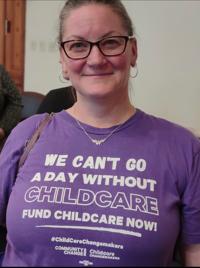Not enough spots and too expensive—committee hears how child-care problems impact state
- By Kayla Barlow, TheStatehouseFile.com
- Â
“I gave birth on a Sunday and was back at work that Thursday,†day-care operator Kelly Dawn Jones said through tears
“I was denied child care because I was $13 over [the hourly income requirements],†said mother and child-care provider Deondra Steward of Unique Cherubs Family Childcare.

These stories and more left Sen. Ed Charbonneau, R-Valparaiso, “flabbergasted†with the current state of child care in Indiana. As chair of the Interim Study Committee on Public Health, Behavioral Health, and Human Services, he highlighted the depth of the child-care problem in Indiana at an Aug. 9 committee hearing at the Indiana Statehouse. The meeting was the committee’s first so far in 2023.
“It’s impossible to hear [these stories] and not be [impacted],†the senator told TheStatehouseFile. com shortly after the hearing adjourned.
Not only is child-care accessibility affecting countless Hoosiers, the lack of affordable child care has proved detrimental to Indiana’s economy.
According to statistics provided to the committee by Erin Emerson, CEO of the Perry County Development Corp. and Perry Childcare Initiative, Indiana employers are losing roughly $1.8 billion a year due to costs related to child care.
In addition, the U.S. Chamber of Commerce Foundation estimated that, due to child-care-related costs, Indiana will lose between $5.7 billion and $8.6 billionover the next decade.
These costs are just the tip of the iceberg of a slew of child-care issues. Other concerns discussed during the hearing included a series of regulations related to child care that some said need reform.
For instance, Emerson presented statistics to the committee that while 67% of children may need care because their parents are working, 46.9% of Indiana children under the age of 5 who need child care do not have access to it. Furthermore, Emerson shared that the average cost of center-based child care is 15.2 % of the state’s median income. This lack of access is due both to the unaffordability of child-care costs and the rising number of child-care deserts (defined by the Center for American Progress as a place with no child-care providers or “more than three times as many children as licensed child-care slotsâ€).

Issues with the Child Care Development Fund (CCDF), which is administered in the state by the Indiana Family and Social Services Administration, were discussed as well.
“You could not make more than $11.18 an hour as a single parent … with a full-time job,†said Emerson about current CCDF income eligibility limits. “If you want to be able to afford your child care, we are almost incentivizing women to go out and get low-paying jobs.â€
One reform proposed by Emerson was to increase the CCDF income eligibility guidelines to allow for a single parent to earn more than $14.22 an hour and still qualify for child-care assistance.
Emerson and others also expressed concern with the current age requirements, which state that individuals must be at least 21 to work with infants and toddlers.
“It’s just kind of an arbitrary number. I’ve known 18-year-olds that I’d leave an infant with, and I’ve known 45-year-olds that I never would [leave an infant with],†said Emerson.
When it comes to child-care legislative reform, Charbonneau thinks lowering this age requirement will be a good place to start.
“The no-brainer is to change the age regulation,†he said.
Charbonneau added that he still wants to ensure child-care workers are high quality, noting the stories he heard during the hearing of women who, under the current regulations, have had sitters quit and walk out “just shouldn’t be happening.â€
“It’s not just a funding issue … It’s pervasive,†he said.
Other ideas for reform included increasing the wages for child-care staff and making child-care workers eligible for vouchers for child-care assistance so that they can afford care for their own children.
To aid in this effort, Sam Snideman of the United Way of Central Indiana (and others) proposed revisions to Indiana’s economic approach. Snideman noted that the current approach has led to licensing and regulation issues, reimbursement rates that do not account for child-care costs, low wages, and a lack of assistance to children of child-care workers.
Proposed models would mitigate these issues by increasing income eligibility limits. Snideman and others provided examples of initiatives in other states such as the Michigan Tri-Share program, in which employers, employees and the state “share the cost of child care equally.â€
One of the United Way’s close partners, Prosperity Indiana, is also a strong advocate on this issue.
“Prosperity Indiana recognizes the need for Indiana to include options for child care as part of a comprehensive community economic development strategy for the state so that Indiana can be a place where all Hoosiers can live and work in an environment that provides equitable access to economic and social opportunity,†Andrew Bradley, policy director of Prosperity Indiana, said in an email to TheStatehouseFile.com.
“If unmet, the need for child care acts as a barrier to stable employment and equitable health and economic outcomes.â€
This is something that Emerson from Perry County also voiced. She stated child-care costs “are a major barrier to the workforce.â€
In addition to the economic impact, the societal and personal impact of child care is one that Emerson has borne witness to firsthand.
“I think as a society we undervalue that role [of child care] … I have gotten to know teachers and the caregivers at [the Perry Childcare Initiative] very, very well, and I truly believe that they are doing some of the most important work,†said Emerson. “They are molding the personalities and the work ethic and the soft skills of our future generations, our children … It is providing a critical, critical service.â€
Deondra Steward of Unique Cherubs Family Childcare holds similar views.
“What I would like people to know is that child care isn’t just a parent issue or a community issue. It’s a country issue,†said Steward. “It’s an issue that will take parents, providers, educators, legislators, senators, businesses, and communities to come together to benefit our children, families and the future of our growing communities.â€
The study committee is set to meet again on Sept. 13 in room 431 of the Indiana Statehouse. According to the Indiana General Assembly, the meeting will discuss the “prevalence and impact of mental illness†“alternative treatment options,†and policies that enable access to therapy for those experiencing mental illness, especially veterans and first responders.
FOOTNOTE: Â Kayla Barlow, of Indianapolis, is a Howard University junior working for a month with TheStatehouseFile.com,Â





